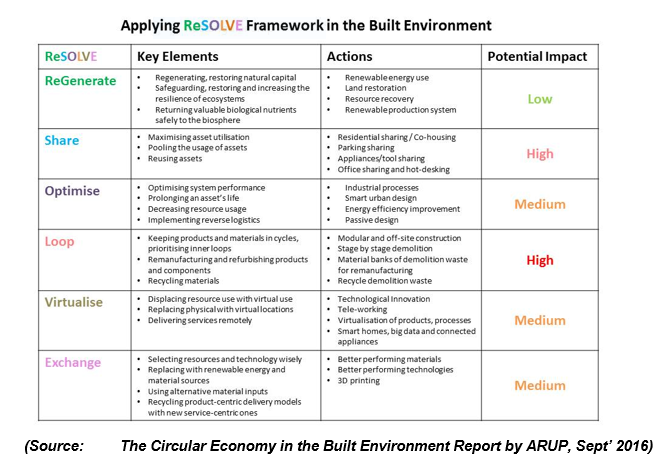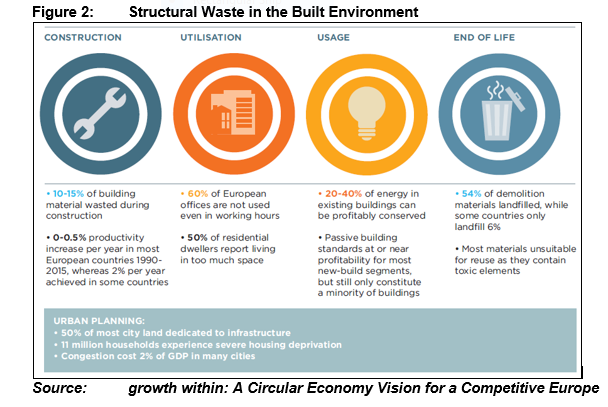Circular economy in the built environment
Contents |
Introduction
‘Circular economy’ can be explained as an approach toward an economy that closes the resource loop. In other words, a circular economy offers an alternative approach to economic growth by using fewer resources and minimising the impact on natural resources.
According to a report published by the Ellen MacArthur Foundation (Growth within: a circular economy vision for a competitive Europe 2015), this concept rests on three core principles as seen below:
- Preserve and enhance natural capital;
- Optimise resource yields, and
- Minimise system risks and improve its effectiveness.
In a circular economy, the aim is to maximise the utility of the existing infrastructure across the product value-chain, hence the waste from one system can be used as the input into another system. In this article, the focus is narrowed down to the built environment with some key characteristics to be noted:
- Compared with other sectors, buildings do not typically operate on a take-make-dispose system;
- Modern buildings are typically constructed for an average lifecycle of 65-70 years while the average lifecycle of most other manufactured products is less than nine years, and
Current resource use by the engineering and construction industry

Realising the potential of the circular economy requires a systems approach to all aspects of the value chain right from design, through technology, financing, procurement, construction, operation, maintenance and to recycling. Consequently, scaling-up cross-sector collaboration within the construction and infrastructure sector will be required to innovate and enable transition towards a more holistic circular economy approach.
Becoming completely circular

|
The Ellen McArthur Foundation conceptualised the ReSOLVE framework, to explain the circular economy based on the fundamental notion that “material flows can be divided into two interacting loops: the technical and biological resource cycles”. Although most projects can exemplify certain elements of circularity, very few projects in the built environment can actually incorporate all the elements to become completely circular. The ReSOLVE framework offers businesses everywhere a methodology to incorporate circular strategies and growth initiatives. The six elements of the ReSOLVE framework, as listed in the table above, can be applied to products, buildings, neighbourhoods, localities, councils, cities, regions or even to national economies.
Policy action and incentives at national and regional level can drive investment to support the transition of integrating circularity into the whole lifecycle of the infrastructure asset and encourage stakeholder participation. For example, the EU Action Plan for the circular economy, launched in December 2015, outlined a set of specific actions, and generic obstacles to support the EU’s transition to a circular economy. The EU’s call for all new buildings to be nearly zero-energy by the end of 2020 implies complete enforcement of the EPBD as a policy drive to achieve circular economy in the built environment’s energy consumption. In the UK, the Part L of the Building Regulations and rental market policies such as MEES have resulted in actions to improve the energy performance of the current building stock.
The built environment sector is very complex with multiple stakeholders, long lead times, massive investments and capital risks. Some key challenges that can be foreseen in adopting a circular economy are:
- Increase in capital costs
- Creation of stranded assets
- Occupant safety concerns on use of recycled materials
- Potential contamination of demolition waste with toxic materials such as paints, adhesives, insulation, and wall-covering materials, and gaps in continuity of ownership and control, as there are multiple stakeholders and longer timescales.
BSRIA’s involvement in the circular economy
BSRIA is exploring the potential of current industry practices to transition toward a circular economy approach. Modular and offsite construction, improvement in construction process using Soft Landings, better operation and maintenance of building technical systems through testing, thermographic surveys, failure assessment and whole lifecycle analysis are seen by BSRIA experts as methods that will support adoption of circular economy principles in building services.
While the circular economy paradigm offers a new alternative approach to economic growth, strong leadership with a coherent vision based on well-informed research is required to create a roadmap that can translate the high-level principles to sector-specific processes of the built environment. As a step forward in this direction, BSRIA has recently confirmed its bi-lateral engagement with the UKGBC and therefore with the wider industry on ‘circular economy in the built environment’.
About this article
This article was written by BSRIA and first appeared on its website https://www.bsria.com/uk/. BSRIA is an ISO 9001-registered test, instruments, research and consultancy organisation, providing specialist services in construction and building services.
Related articles on Designing Buildings
- 5 things leaders can do to create a truly circular economy.
- A social, circular economy.
- BREEAM Construction waste management.
- Circular economy - transforming the world’s number one consumer of raw materials.
- Construction waste.
- Cradle to cradle product registry system.
- Design for deconstruction.
- End of life potential.
- Environmental - sustainable - green design.
- Examining the 2021 construction materials shortage.
- Green supply chain management.
- Impact of the sharing economy on construction craft labour and equipment markets.
- Life cycle.
- Mean lean green.
- Recyclable construction materials.
- Recycling.
- Reduce, reuse, recycle.
- Renewable energy.
- Stranded assets.
- Sustainable materials.
- Sustainability.
- Waste management plan.
--BSRIA
About the wiki
Anyone is welcome to use and contribute to the wiki in different ways.
[edit] Engaging with the wiki
You can:
- Contribute to existing articles
- Create articles
- Share articles through social media and other channels
- Contact the CIRCuIT project to let us know what you think and how we can improve
[edit] Add your own content
To contribute to or create an article, you can follow these steps:
- Register as a user
- Read through the editorial policy and guidance on writing and contributing to articles
- See the detailed help page on tips on writing wiki articles
- Try editing a test article
- If editing an article, select 'Edit this article' underneath the article title
- If creating a new article, select 'Create an article'. In the 'Select categories' area, expand the 'Industry context' list and tag 'Circular economy' to add your article to this wiki
[edit] Who is this wiki for?
The articles contain information on implementing circular economy approaches in construction that could be relevant to:
- Architects
- Construction contractors
- Designers
- Developers, owners, investors
- Engineers
- Landowners
- Manufacturers and supplier
- Universities and research
- Urban planners
[edit] About CIRCuIT
The Circular Economy wiki is supported by the Circular Construction in Regenerative Cities (CIRCuIT) project, which is funded by the European Union's Horizon 2020 research and innovation programme. CIRCuIT is a collaborative project involving 31 ambitious partners across the entire built environment chain in Copenhagen, Hamburg, Helsinki Region and Greater London. Through a series of demonstrations, case studies, events and dissemination activities, the project will showcase how circular construction practices can be scaled and replicated across Europe to enable sustainable building in cities and the transition to a circular economy on a wider scale.








